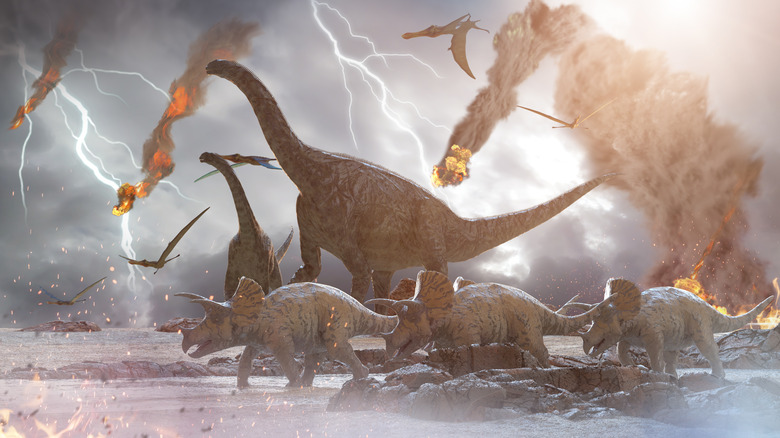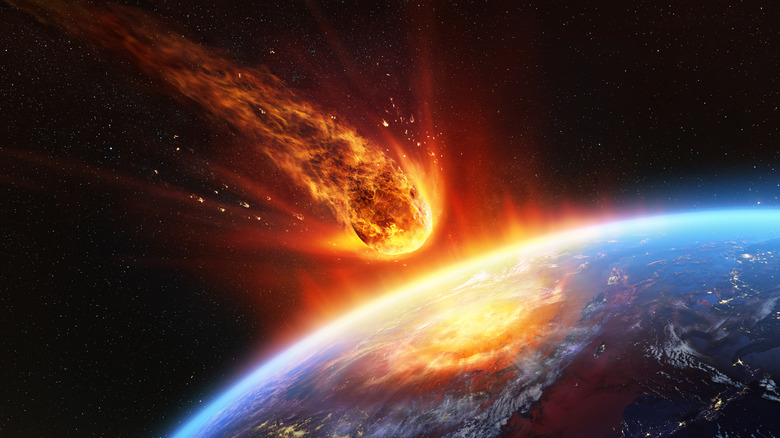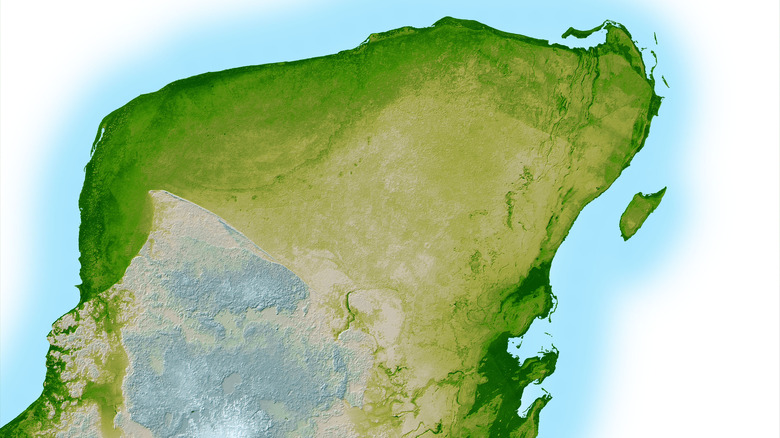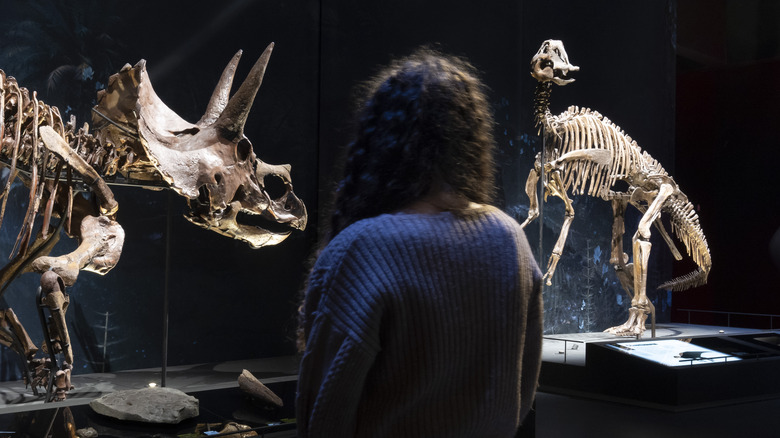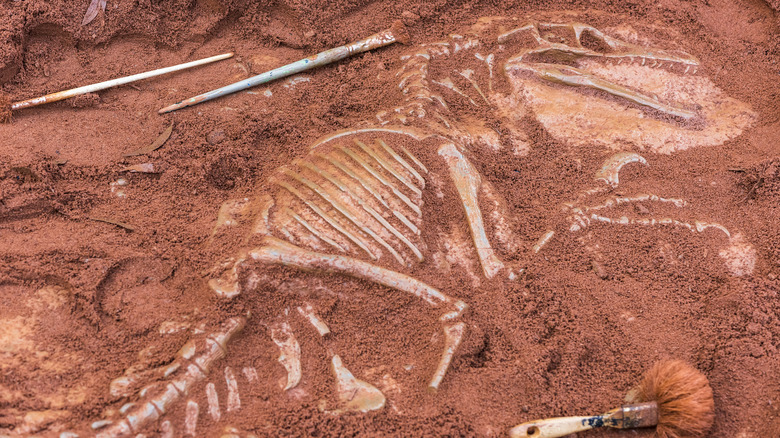Some Theories Suggest Dinosaurs Died Out Quicker Than Previously Thought
Dinosaurs were some of the most formidable, powerful, ferocious, and downright enormous animals in history. The iconic Tyrannosaurus rex, for instance, was up to 12 feet tall and around 40 feet long. It was certainly not the largest of the dinosaurs, but the tyrant lizard king retains a special place in our hearts.
Naturally, we have the "Jurassic Park" franchise to thank for that. Even this fantastical imagining of just how humanity and dinosaurs may have coexisted makes one thing very clear, though: we probably wouldn't have been bosom friends. Here in the real world, humankind doesn't have natural predators, but there are animals that will harm, hunt, and partially eat us on occasion. It's difficult to imagine that some dinosaur species wouldn't have done the same if they'd had the opportunity.
Fortunately, we'll never actually have to experience the horror of looking out of our bedroom windows at night and seeing an inquisitive Tyrannosaurus eye staring in at us (a la "The Lost World: Jurassic Park"). As UCSB ScienceLine explains, "The Mesozoic era, commonly called 'the age of the dinosaurs,' lasted from 250 to 65 million years ago ... about 60 million years between people and dinosaurs."
What happened to these formidable reptiles? The puzzle is still being pieced together, and it seems that they may have become extinct quicker than scientists believed.
The most infamous meteorite in history
Famously, a vast meteorite is believed to have spelt doom for the dinosaurs and many of the fellow creatures they shared the Earth with around 66 million years ago. Professor Paul Barrett of the Natural History Museum explains, "An asteroid impact is supported by really good evidence because we've identified the crater. It's now largely buried on the seafloor off the coast of Mexico. It is exactly the same age as the extinction of the non-bird dinosaurs, which can be tracked in the rock record all around the world."
The asteroid impact theory, as it became known, was first raised in 1980. The evidence proposed here, as with any radical concept of its type, took some time to be accepted. It wasn't until 2010 that it was widely endorsed by the scientific community, as evidenced in the review "The Chicxulub Asteroid Impact and Mass Extinction at the Cretaceous-Paleogene Boundary" via Science. The document states, "The temporal match between the ejecta layer and the onset of the extinctions and the agreement of ecological patterns in the fossil record with modeled environmental perturbations (for example, darkness and cooling) lead us to conclude that the Chicxulub impact triggered the mass extinction."
With this seemingly settled, scientists began (and continue to have) the next debate: both the immediate and lasting effects that the meteorite impact had.
After the impact
The asteroid that hit the Earth was reportedly up to 15 kilometers wide. It left a vast trench in the Earth that was 10 times that size. This all adds up to devastation on an unimaginable scale. In June 2016, National Geographic reported that scientists were gleaning greater insight into how the calamity would have unfolded after gaining unprecedented access to study rocks from the impact zone.
One such scientist, Joanna Morgan, explained just how bleak the prospects of survival were in the immediate aftermath of the impact. According to Morgan, those "within 1,000 kilometers (625 miles) ... would be instantaneously, or within a few seconds, killed by the fireball."
Still, this doesn't account for all dinosaur life on the planet at the time (quite apart from any other species). It was not an immediate vaporization of all life, but for those further from the zone of Chixculub, the mass extinction may well have occurred at a remarkable pace.
The planet's climate was a problem too
Prior to the theory of the impact becoming more widespread, another theory suggested that the changing climate of the Earth (still a hot button issue today) was responsible for the dinosaurs dying out. This process occurs naturally with or without human activity (though the extent and pace of it are influenced by our actions), and the geography of the planet has changed to an astonishing degree since dinosaurs lived. Antarctica and Australia, among other modern-day continents like South America, were once all connected as a single vast supercontinent dubbed Gondwanaland.
This volatile prehistoric world, even prior to the impact, was beset by an array of natural disasters. A 2020 study in the Proceedings of the National Academy of Sciences — "Asteroid impact, not volcanism, caused the end-Cretaceous dinosaur extinction" — explores some of these. The researchers state that as well as the asteroid, the mass extinction coincided with "heightened volcanism associated with the Deccan Traps." Though this volcanism undoubtedly impacted the atmosphere, the research suggests that it was not the major factor. "Given that the hypothesized asteroid-induced cooling likely drove the extinction, a pulse of warming ... just prior to the extinction may have acted as a buffer against cooling induced by the Chicxulub impact," the study reads.
The death of the dinosaurs, then, may have been a faster asteroid-induced process than one caused by the slow and inevitable march of climate change.
The majority of dinosaurs may have only survived for months afterward
One theory suggests that the aftermath of the impact was so severe that these majestic creatures disappeared in short order afterward. Researcher Mike Follows suggested to New Scientist in 2019 that the asteroid "would have created a massive plume of vaporized rock. Within hours, this probably condensed into a rain of molten rock. This in turn could have killed most organisms out in the open and ignited global wildfires."
Such conditions, naturally, would have been devastating for plant life too. A 2017 study in the Proceedings of the National Academy of Sciences from the National Center for Atmospheric Research and the University of Colorado Boulder estimated that 15,000 million tons of soot would have reduced temperatures, dimmed the skies, and impeded plants' capacity to photosynthesize. These effects, reportedly, could have lingered for around a year and a half. Though this work didn't take into account factors like the Earth's condition then (its current state was used in the modeling), it hints that the dinosaurs' days were clearly numbered, and the days must have been quite dark and terrifying.
According to Follows, "It is possible that most of the extinctions may have happened within months of the impact."
